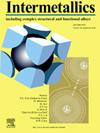The fabrication and characterization of new NiCuTiZrFe high entropy shape memory alloys with exceptional functionality
IF 4.3
2区 材料科学
Q2 CHEMISTRY, PHYSICAL
引用次数: 0
Abstract
In the present study, the multicomponent Ni25Cu25Ti35-XZr15FeX (X = 3, 5, 7, 10) high-entropy shape memory alloys (HESMAs) were designed. Moreover, the effect of Fe content on the microstructural features, martensitic transformation behaviors and mechanical/functional performances was investigated. The results demonstrated that the as-casted NiCuTiZrFe HESMAs exhibited the typical dendritic structures. The as-casted Ni25Cu25Ti35-XZr15FeX HESMAs with the lower Fe content consisted of B2 phase and HCP phase. With Fe content increasing, the amount of FCC phase gradually increased. In proportion, the fracture strength of as-casted Ni25Cu25Ti32Zr15FeX HESMAs continuously decreased from 2019 MPa to 1364 MPa, meanwhile the microhardness was also reduced from 593.33 HV to 146 HV, as Fe content increased from 3.0 at.% to 10.0 at.%. In contrast, the as-casted Ni25Cu25Ti32Zr15Fe3 HESMAs exhibited a superior combination of higher compressive strength and microhardness as well as the excellent superelasticity with the recoverable strain of 7 %. Furthermore, the Ni25Cu25Ti32Zr15Fe3 HESMAs demonstrated the good superelasticity stability, which can be ascribed to the saturated higher density dislocations during the initial compressive cycles.
求助全文
约1分钟内获得全文
求助全文
来源期刊

Intermetallics
工程技术-材料科学:综合
CiteScore
7.80
自引率
9.10%
发文量
291
审稿时长
37 days
期刊介绍:
This journal is a platform for publishing innovative research and overviews for advancing our understanding of the structure, property, and functionality of complex metallic alloys, including intermetallics, metallic glasses, and high entropy alloys.
The journal reports the science and engineering of metallic materials in the following aspects:
Theories and experiments which address the relationship between property and structure in all length scales.
Physical modeling and numerical simulations which provide a comprehensive understanding of experimental observations.
Stimulated methodologies to characterize the structure and chemistry of materials that correlate the properties.
Technological applications resulting from the understanding of property-structure relationship in materials.
Novel and cutting-edge results warranting rapid communication.
The journal also publishes special issues on selected topics and overviews by invitation only.
 求助内容:
求助内容: 应助结果提醒方式:
应助结果提醒方式:


